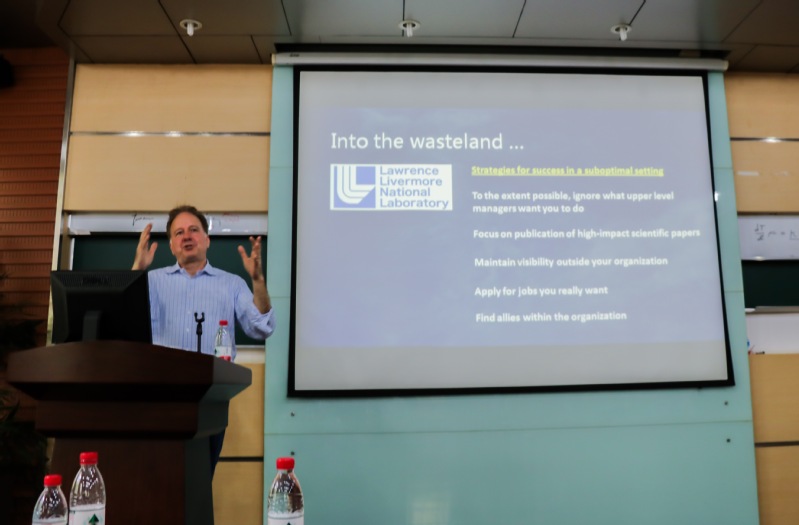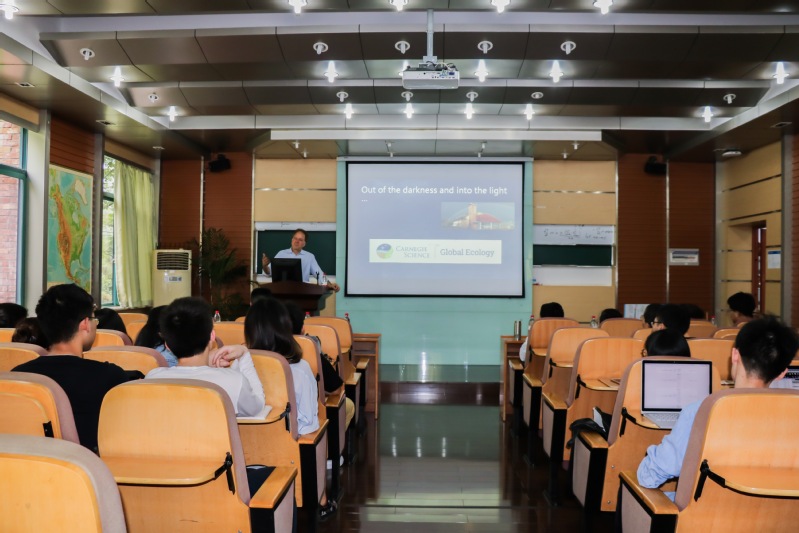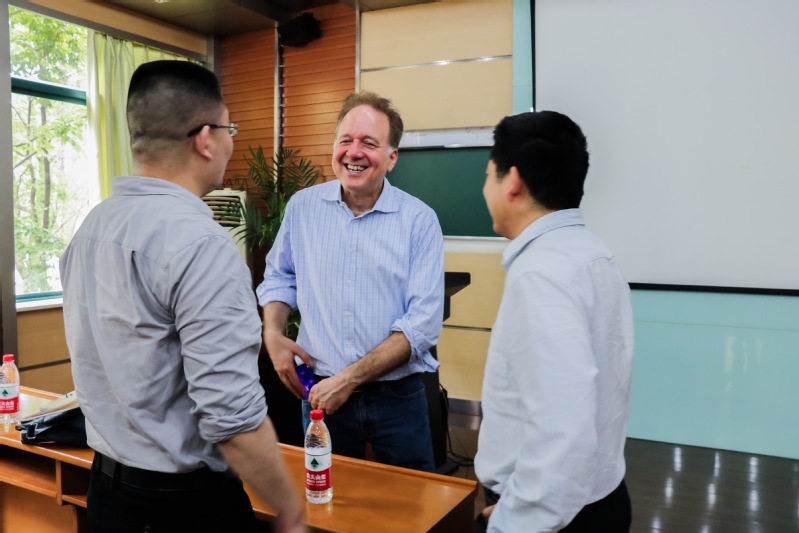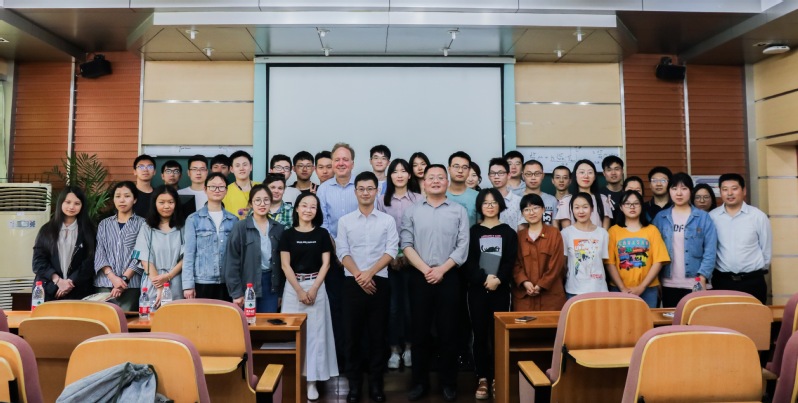Editor: 邵丹蕾 Author: Zhao Mengying Time: 2019-05-23 Number of visits :228
May 16th, Ken Caldeira, a climate scientist at Carnegie Institution for Science, gave a talk on career choices and strategies in climate science and shared his life experience with students at the School of Earth Sciences, Zhejiang University. Ken’s research is related to climate, carbon, and energy systems. He is also a Professor (by courtesy) in the Department of Earth System Science, Stanford University. In his view, success is a combination of doing core work and making good strategic decisions.

Follow your heart. Don't be overly strategic.
Ken started his career as a software developer on Wall Street. He felt depressing working there, “I was helping rich people get richer. It was not much of fun.” Since then he started to take night courses just for fun in the university which was just a few blocks away from his apartment. Surprisingly, he became the best student and received fellowship to continue his study. “I didn't really plan things out. I didn't plan getting a PhD originally. Even when I was a child, I didn't think I will become a scientist.” He decided to go back to school and continue his study.
Thanks to his mentor, Ken wrote the shortest Master’s thesis (2 pages long) in the university’s history and had it published in Nature. It was a single author paper. “My mentor Mike Rampino was selfless. He sat down and went through the paper sentence by sentence with me, improving my grammar, but at the same time, he felt he shouldn’t be the co-author because it was all my ideas. This is unheard today.” What happened a week ago was that Ken was in New York helping his mentor do statistical analysis. “The altitude of helping people is really important for long-term success.” He said.
Determinants of early success.
What determines early success? The answers given by Ken are intellectual curiosity, reading and being aware of scientific controversies. Being surrounded by people with ambition is also a benefit. Ken was surrounded by people who was always trying to get paper published on Nature. “As a matter of fact, I was of course trying to get paper into Nature.”
What happened then? More curiosity driven Nature papers were published. Ken’s friend Prof. Jim Kasting played an important role in this. He was the only person that got more excited about Ken’s ideas than Ken himself. “I would say something and I throw away my ideas, but he would say ‘That’s great!That’s a Nature paper.’ That would make me work on it, and think maybe it is a Nature paper. That’s one of the most productive periods in my life. I was lucky to have someone around telling me that my idea is great.”
Strategies for success in a suboptimal setting.
Speaking of jobs, Ken tells us he must be a terrible job interviewee. “I guess I just write short papers and I didn’t have much research experience.” A friend who was the head of Lawrence Livermore National Laboratory, gave me a job. And after a month later, we were trying to build a couple of ocean atmosphere carbon cycle model which didn’t exist that time.” However, Ken was simply hired to do simple toy model that would predict what complicate model will do.

“Then the people hired me to join one research program and I moved to Washington. However, people there said ‘we don’t do toy models’. There was no body doing ocean biochemistry coupled model and I said OK I can do this.” Ken was paid to build models, writing scientific papers was a part-time job for him. However, each time Ken coupled model he wrote high-quality scientific papers. The group did the first geoengineering simulation combined chemical biophysical affects land cover change for 3D climate model. It was also the first American group making coupled bio-carbon simulation. What’s the strategy of success there? It’s maintaining visibility outside your organization. For Ken at that time was keep writing papers and got them published.
Into the light...
It took me 12 years till I finally get a job I want.” After that Ken stood out from suboptimal setting, he got a position at Carnegie Institution. How did Ken get this job?

The director of one of the departments in the institute was heading some panels in Washington on carbon cycle science research. Ken was doing this very well and had been to the panel many times. “It’s personal networking. Almost every job involves some kind of personal contact in one way or another. I had a number of Chinese postdocs, and I don’t want make general assertion of people from different countries. But I see a lot of times their strategy to success is trying to attach themselves with senior persons. However, in United States the strategy really works is to build network between peers. Your whole peer network in 20 years will help you find job or find people to hire.”
Focus on being helpful
Ken started to receive funding from Bill Gates tobring in postdocs about 10 years ago and then try to help postdocs to find good projects that facilitate their success. In his view, people give out money when it is in their best interest.
“So one of the thing I feel really fortunate is that for the last 10-12 years I have been helping Bill Gates, he’s also funding about 8-10 postdocs from my group each year.”
It all started with Gates wanted to learn about geoengineering and climate science. The people around him found Ken and David who is now at Harvard. After a year, Ken and Bill Gates had about 4 sessions, 2 tutorials on climate science and geoengineering. “His people said, ‘Bill is ready to give you some money. You just have to say what your delivery will be and what’ll you do with this money.’ But I said to them, ‘I’m not going to tell you what my delivery will be, I’m going to tell you what I am going to do. I’m going to hire the best people I can find and encourage them to do the best work they can do. When they achieve something, I’ll let you know what they did.’ I was really in an extremely unusual position, almost unheard in American science for having funding for 10 postdocs and having no concrete delivery at all. I was lucky. One of the keys here is trying to help people and be helpful.”
Another story about being helpful is that once Ken went to see energy program manager, he gave the manager the whole story about what to do, how to do it and how much money is needed. At the end, the manager said “OK, you’ve spent half an hour telling me how I can help you, but I don’t care about it. I want to hear about how you can help me.” You have to be helpful and valuable for other people when you need help yourself.

Q&A session
Q: How do you achieve work-life balance?
A: One of the things I learned from Bill Gates, when I go to meetings I never bring my phone or laptop. Doing one thing at a time. The other thing is that you can exercise daydream. Sometimes I get my ideas at shower or hiking in the woods, you can play with your kids and think about CO2 at the same time. I’ve read the article how do successful people spend their day. It talks about scientists, artists and musicians usually spend only 3 hours a day doing their work. Most of them are up the early morning. Being focus and having a period of time focusing on creative work, not long hours.
Q: Why did you chose to study climate change?
A: I was actually debating between going to neural science or climate change. In the mid-80s, this was an early field. The basis of climate change was not understood. One of the things was in neural science is that graduates are more likely focus on small piece of work and execute experiments in the lab, while in climate science graduate students could do project themselves, so that’s one big factor. The other factor, more psychological, I saw climate attack across the world, I was trying to help the world.
Q:Somehow climate change was put into political view, like Donald Trump, he doesn’t think global warming is happening. What’s your perspective?
A:It’s been a complicated issue. There has been a lot of research of what cause people to believe things. The evidence is that group identity is really important. The opinions belong to part of social groups seem to overwhelm people’s capacity for rational thinking. It’s hard to change the mind of a true climate science denier. It’s better thing to reach the people around us first.
Q:How did you come up with so many great ideas during your research and how could you evaluate it was a good idea?
A: I have a friend, I would say 95% of his ideas are terrible, but he has more ideas in a single day than most people have in ten years. A lot of things are like puzzle. The more you try to think the more you can see. If you only have one idea, you are not ready to write a paper. You should have 5 ideas. The way to having good idea is to have many ideas and choose the good one. Do not be afraid of bad ideas. The crazy guy I mentioned before, a lot of people don't like him at all, because he would be at meeting and say crazy things that don’t make any sense. But he could come up with brilliant ideas. He need people around him to help him understand which one is the good one. So you need to be surrounded by good people and talk to people around you when you come up with many ideas
Q: My mentor chose a field for me, but currently it’s not a hot issue.
A: Follow your heart, don’t be overly strategic. If you only trying to follow the trend, there’re thousands of others trying to do so and you’re not necessarily going to be better than those thousands of other people. Doing something that is a little bit off-trend is a good thing. I did a lot of unfashionable things, such as the first 3D simulation of solar geoengineering. Even the publishers didn't want to publish it because it was too controversial. You have to be convinced that it’s interesting and important. If you are working in this field because it’s only thing you can think up, then that’s not a good idea. But if you look around and think this one is the best, and convinced this is one of the most important and interesting things to do, then you can do it.
Q: How do you see the future of atmospheric science?
A: I’ve been actually expanding energy system modeling in my group. I’m also looking at the boundaries between energy system and geophysical system. I have a postdoc who focuses on regional climate and regional geoengineering. There are human activities, human is transforming the plant, how this transformation is going to affect the planetary functioning. If you want to be relevant to human decision, I think it’s going to be more challenge.

